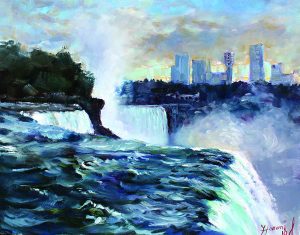by Mike Hudson
Fr. Louis Hennepin was a priest, an adventurer and a teller of tall tales who would undoubtedly get a kick out of the fact that, nearly 400 years after his birth, the first art depicting the natural wonder of Niagara Falls is still often mistakenly attributed to him.
Hennepin, a Jesuit, was sent by the King Louis XIV of France to North America with the expedition of Rene Robert Cavelier, Sieur de la Salle in 1675 in order to convert Native Americans to Catholicism. It was a thankless task, and in 1678 he jumped at the chance to accompany LaSalle to the Niagara Frontier.

Although often attributed to Father Louis Hennepin, this 1683 woodcut was actually the work of an anonymous artist working his French publisher, and based on Hennepin’s written description of the falls.
While he is generally acknowledged as the first white man to see the falls, the only evidence we have for this is his own word. By the time he published his book, “A New Discovery of a Vast Country in Voyage America (1697), he was the only surviving member of the party.
A woodcut rendered in the book and reprinted many times elsewhere is an inaccurate representation of the mighty Cataract, and for centuries it was believed to have been based on a drawing Hennepin himself made. There is no evidence to support this, and art historians today generally acknowledge the image was executed by a house artist at Hennepin’s publisher based on his written description of the falls.
Still, the Hennepin print touched off a veritable Niagara of paintings, drawings and prints depicting the falls, one that has not gone dry to this day.
British Army officer Capt. Thomas Davies became the first man to paint the falls who’d actually seen them, in his 1767 “An East View of the Great Cataract of Niagara,” (See related story). But the golden age of Niagara Falls art was the 19th century, when two artists – Frederic Edwin Church and William Morris Hunt – vied for supremacy in depicting the natural wonder.

The falls continue to spark the creative imagination, as see in this 2010 depiction by Niagara Falls artist Ylli Haruni. (Spelling in cq)
Church was a central figure in the Hudson River School of American landscape painters while Hunt aligned himself with the contemporary but somewhat more effete and French influenced Barbizon School.
Both painters’ works are characterized by extraordinary detail, romanticism and luminism. Art historians say the romanticism that was the hallmark of both the Hudson River and Barbizon schools was a reaction to the Enlightenment, and its boring old devotion to logic and order.
While Church executed just two paintings depicting the falls – one of which now hangs in a British museum – Hunt painted a dozen. Still most critics and historians give Church efforts the nod, though whether this is evidence of reverse snobbery against the Barbizon School and the fact Hunt died a suicide or because they are actually better is a matter of debate.

Niagara Falls, From the American Side is an 1867 masterpiece by Frederic Edwin Church, considered the dean of Niagara Falls painters.
Today, numerous artists continue in the tradition of Church, Hunt, Davies and whoever drew Hennepin’s picture for him. One of those is Ylli Haruni, an Albanian who now calls Niagara Falls home.
His work hangs in the Albanian National Art Gallery as well as many other prominent collections around the globe.
Niagara Falls is one of the most, if not the most, painted landscape in history. The many depictions of the natural wonder have fired the imaginations of generations of tourists, based on the haunting images seen in museums or on picture postcards.




















